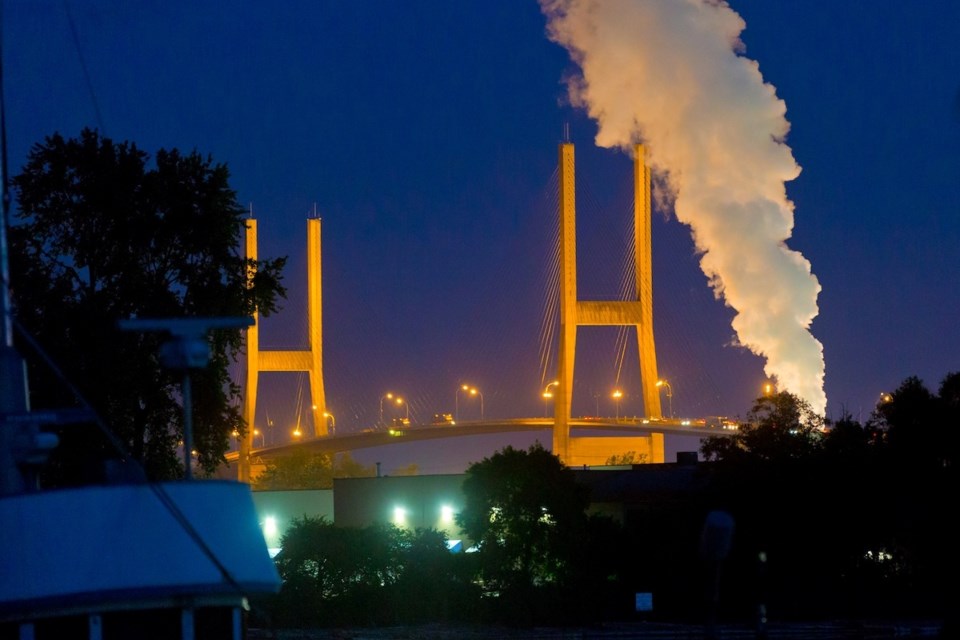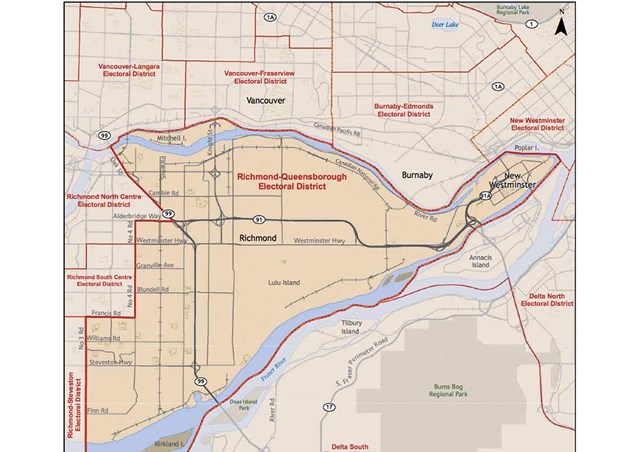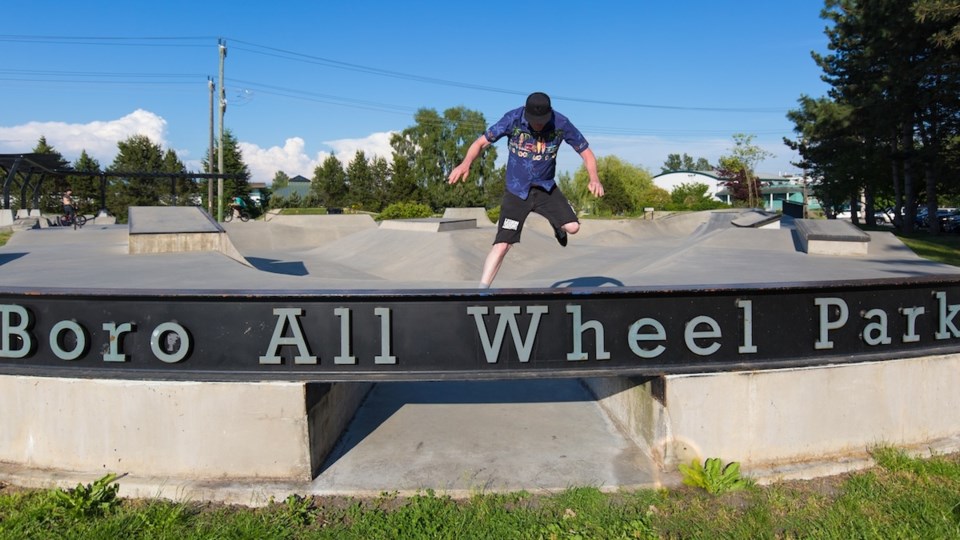New Westminster resident Gavin Palmer and Richmond resident Byron Stevens had never met. They are both active members of their neighbourhoods, Queensborough and Hamilton, respectively.
But, for the first time in a long time, their local, community interests, which have long thought to be more closely allied with one another than with their overlord municipalities, may finally come together again — politically, at least.
For the first time in 132 years, Queensborough could be politically separated from New Westminster, as a provincial electoral line may be drawn down the middle of the Fraser River.
The British Columbia Electoral Boundaries Commission’s proposal to shift the boundary for Richmond East so that it would absorb Queensborough come the 2017 election, would also represent the first time in 70 years that Queensborough and Hamilton residents were represented by the same politician.
The last time that happened was in 1947 when New Westminster and Richmond shared a Member of Parliament. (In 2012 a proposal by the Federal Electoral Boundaries Commission to move Queensborough into Richmond was quashed due to opposition.)

Busting the boundary
Could this further lead to Queensborough re-unifying Lulu Island under one municipal entity? The last time this was the case, was in 1885.
Only a true Richmond history buff would know that Queensborough, as we know it now, was a part of Richmond for six years, from the establishment of the municipality in 1879 to 1885, when a Letters Patent document redrew the boundaries.
That Letters Patent, drafted on March 2, 1885, and later published in the British Columbia Gazette, obtained from the Richmond Archives, reads that the boundaries of Richmond would be shifted:
“Following the meanderings of the north bank of the North Arm of the Fraser River to the southeast corner of the Municipality of New Westminster; thence across the North Arm of the Fraser River to the northeast corner of Section 25, Block 5 North, Range 4 West; thence true south to the south shore-line of Lulu Island.”
This redrawing meant the three islands, which have since been infilled to form Mitchell Island, became part of Richmond, and the line which was drawn “true south” at Section 25 formed what is now Boundary Road.
According to The History of Lulu Island, written by pioneer Thomas Kidd in 1927, Queensborough was a strategic acquisition for the capital of New Westminster as it sought flat land to become a terminal of the Canadian Pacific Railway.
“Richmond, not considering it (Queensborough) of much value to her in the near future, consented to the change,” wrote Kidd.
So, when a public hearing for the creation of Richmond-Queensborough Electoral District was held just last month, it was a case of history revisited.

Balancing the numbers
The logic behind the current proposed boundary shift, which was unanimously supported at the hearing (albeit only a handful of attendees), is that New Westminster is too small for two MLAs but too big for just one. Meanwhile, Richmond is too big for three representatives, but too small for four. So, annex Queensborough and Richmond and New Westminster have just the right balance (about 50,000 people per riding).
The shift raises the question: Does Queensborough belong in Richmond, entirely? And what would that entail? Or, maybe Hamilton and Queensborough should join to create their own municipality? The latter would be a greater long shot than the former, although both are unlikely.
But as hearing presenter and longtime Queensborough resident Martin Eady framed the proposal:
“Queensborough has been overlooked, certainly in the past,” said Eady, noting it was only when more of the land became developable that New Westminster City Hall took notice of it. He added that traffic from Richmond is a major driver of the neighbourhood’s economy.
Eady said that some folks were worried Queensborough would be “lost” from New Westminster with the boundary shift, but he noted the shift would mean New Westminster would be represented by two MLAs, not one, which would actually benefit the city.

Richmond welcomes Queensborough
Meanwhile, Richmond Chamber of Commerce spokesperson, Matt Pitcairn, lobbed a gentle “welcome to Lulu Island” toward Queensborough residents.
“We believe that Queensborough is a welcome addition to Lulu Island,” said Pitcairn, noting both growing communities deserve the same MLA.
Palmer, the president of the Queensborough Residents’ Association, from 2002 to 2012, also spoke to the commission.
“Both Hamilton and Queensborough are very similar. We are both almost forgotten by our respective cities. We seem sort of alienated by our cities. The only time they remember us is when tax time comes,” he said with a chuckle.
However, Stevens, a member of the Hamilton Community Association, said the communities have their differences and over the past decade Richmond has been mindful of including Hamilton in its plans.
“I think at this point in history, I don’t see (unification of Queensborough and Hamilton on the municipal front) happening,” said Stevens.
Both Stevens and Palmer said both neighbourhoods have grown and will continue to grow to the point where they are sufficiently recognized by the city halls.
Richmond Mayor Malcolm Brodie agrees.
“I think Richmond, over the last decade or so, has done a great job of including Hamilton. There’s a new fire hall, a new community centre and they even have some library services,” said Brodie.
When asked, about amalgamation, Brodie said it would likely make more sense for Queensborough to join Richmond because of the Fraser River (even though Hamilton is closer to New Westminster City Hall, as the crow flies).
“I think the geography of the area is more natural that way,” said Brodie, who noted it’s still unlikely to occur given the large tax base in Queensborough (Starlight Casino to name one major contributor).
Who dares to secede?
However, if any daring minds should choose to either unify Lulu Island or have Hamilton secede to join New Westminster, the process would likely be a lengthy and complicated one.
“About a decade ago there was a lot of talk that we would walk away. We didn’t feel we were getting the support from our city; we felt alienated,” said Palmer.
“It (seceding) has been discussed but it would be a difficult thing to accomplish. But, anything is possible,” said Palmer, again with a chuckle
Under the Local Government Act, secession (ie. Queensborough joining Richmond) would require consent, usually via a petition, from 60 per cent of the electors in the seceding area.
Following that, unless waived by the provincial government, both city councils must obtain consent from 50 per cent, plus one, of all electors in the respective municipalities via a referendum (or, the council of the expanding city can gauge public opinion and approve the changes, so long as 10 per cent of the electors don’t object to the proposal by signing a response form within 30 days).
Thereafter, the British Columbia Cabinet would have to approve the changes.
Furthermore, a full accounting of municipal assets, liabilities, leases, taxes, local and utilities must be conducted, and any disputes resolved, according to the Ministry of Community, Sport and Cultural Development, which noted there are no recent instances of a significant shift in a shared municipal boundary in B.C.
Terri Evans, an Urban Studies professor at Simon Fraser University, said when municipal boundaries change, it’s usually where there is little infrastructure.
As well, there are more and more instances where inter-municipal cooperation occurs, such as in the Tri-Cities region.
Nevertheless, as Evans suggests, with or without a municipal boundary shift, with the proposed electoral boundary changes and the further densification of both neighbourhoods (including talks from both school districts about a joint high school) Hamilton and Queensborough are likely to become more of a whole than parts of two distinct cities. “It will be interesting to see what sort of attention (the new MLA) gives to that part of New Westminster,” said Evans.
Another tale of blurred lines in Richmond...

Is Milltown pub Richmond or Vancouver? You decide
If only the line was drawn 30 yards to the south.
As much as Milltown Bar and Grill boss Scotty McVicker loves Richmond, he wishes his premises was in Vancouver.
Well, it is; no, actually it’s not.
You decide: If you head north on the Arthur Laing Bridge and, once on the Vancouver side, you hang a sharp left over the railway track and then, via a 300-metre long causeway, drive onto Richmond Island — are you in Vancouver or Richmond?
The answer, officially, is that you’ve crossed 30 yards into Richmond; much to the chagrin of McVicker.
“We are very much in no-man’s land and if we could find a way to move the island closer to Vancouver, that would be great,” laughed McVicker, who opened the popular pub just over a year ago.
“It would be good to be in Vancouver for no other reason than the confusion; but we kind of have fun with it.
“But I would be naive if I thought it hasn’t cost us customers.”
The Milltown Bar and Grill and its accompanying marina, sits on tiny Richmond Island, in the shadow of the Arthur Lang, although some of the moorage docks are actually positioned in Vancouver.
Richmond Island became the city’s namesake island only after 1885 when a Letters Patent redrew the municipality’s boundaries along the north arm of the Fraser River.
The island is Musqueam territory, administered by Port Metro Vancouver’s North Fraser Terminals Inc. and leased to the Milltown marina.
The island, said McVicker, wasn’t always accessible from the land and was a sawmill in the early 1900s, before belonging to lumber giant Canfor in the ‘50s.
Multiple levels of government
“We’re on federal land and we pay our property taxes through our rent (to the port), so I’m not sure what city they go to?” said McVicker.
“We just lease the building and we have to deal with all levels of government.
It would be a lot easier if it was in Vancouver.
“When we opened a year ago, everybody we dealt with were great, but we had to go back and forth between Richmond and Vancouver because nobody was quite sure, at first, who was responsible for what.”
After crossing the Fraser River many times prior to opening the Milltown’s doors, McVicker eventually got his occupancy permit from the Richmond Fire Department; his business license from the City of Richmond and his liquor license from the provincial board.
With all the relevant documentation sorted, all that’s left these days is to explain the geography to some confused customers.
“We’ve changed it on Google maps a couple of times because, if you typed in Richmond, it wouldn’t come up, but if you typed in Vancouver, it would come up,” said McVicker.
“When you’re opening up a new place, it’s the last thing you want to have to deal with; as we are in the people business.
“When you have to explain to people that you drive over the Arthur Laing, they start asking, “but that’s into Vancouver?”
McVicker said the island, with no sewerage, uses a septic system, with water supply coming from Vancouver.
“We haven’t, thankfully, had to test what fire department will come, but when we called 911 — someone fell off their bike — Vancouver Police arrived,” added McVicker.
Richmond wants control
It’s unclear if the City of Richmond receives a monetary advantage for having the island.
According to the city, it received about $12,000 in property taxes in 2014 from the establishment, and after the marina was built, it received about $33,000.
When the marina was proposed in 2012, developers had to sign an indemnity agreement whereby the city would absolve itself of responsibility for maintaining the dyke.
“It protects the City from being liable for flood or erosion damage should it occur,” said Richmond’s communications manager Ted Townsend, who said the city could not provide a cost-benefit analysis of the island.
Townsend said operating costs, such as firefighting and policing, for the island are likely to be “minimal” each year. In fact, fire services are reduced for the island, under the agreement, and the city has an agreement with Vancouver Police to be first-responders to an incident; once Richmond RCMP show up from the airport, they would take over any investigation.
Even if the island were to cost the city more than it gains, Townsend said holding the island in Richmond’s jurisdiction gives the city strategic control of the area, such as how to effectively manage the river’s environment.
